Magnetization direction refers to the alignment of the magnetic field lines within a magnet, essentially the path the magnetic field takes from one pole to the other. Different applications utilize different magnetization methods, such as axial magnetization (where the magnetic field lines extend along the thickness of the magnet), radial magnetization (where the magnetic field lines extend from the center outward or in opposite directions), and multipolar magnetization (where multiple poles are formed on the same magnetic surface).
The magnetization direction determines the magnet’s magnetic field distribution and adsorption properties, making it crucial to select the appropriate magnetization direction when designing magnetic components or magnetic circuits to achieve optimal magnetic results.
At cnm-magnet We offer a variety of custom magnetization services, and you can contact me at any time.
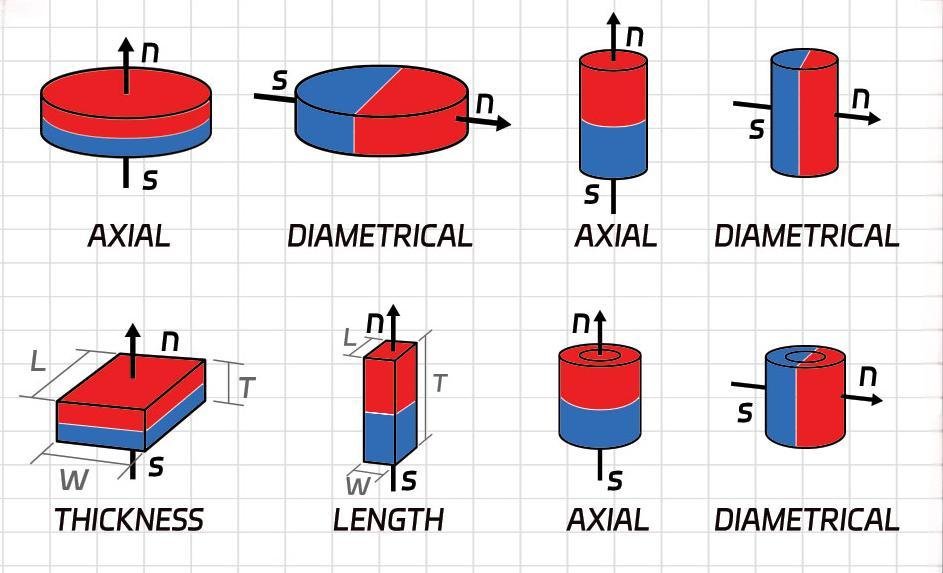
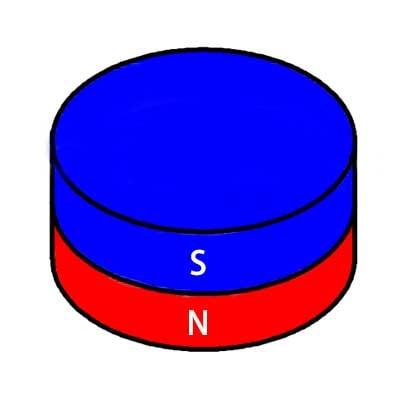
Features:
Axial magnetization’s magnetic field is applied in the direction of the object’s axis, typically using a solenoid or an electromagnet with the magnetic field lines aligned axially Axial-magnetized discs demonstrate 35% stronger holding force than diametric versions in same dimensions.
Key Applications:
Sensor triggers, Encoders, Magnetic couplings, Speakers, Actuators, Motors, Magnetic storage devices, Aerospace, Medical devices, Particle accelerators, Electronics, Craft, Magnetic hook, etc.
Advantages:
| Uniform Magnetic Field | It ensures a consistent and uniform magnetic field along the length of the object, which is crucial for many applications. |
| Ease of Implementation | It is relatively straightforward to apply an axial magnetic field using standard electromagnetic techniques. |
| Compatibility with Existing Designs | Many existing magnetic devices and systems are designed to work with axially magnetized components. |
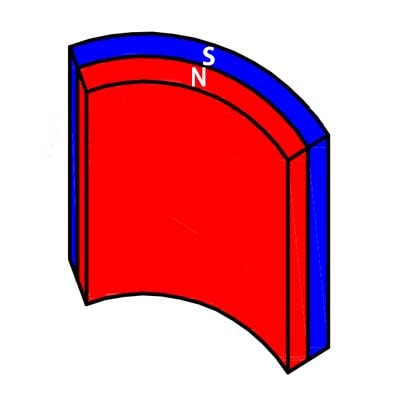
Features:
A magnetic orientation technique where the magnetic moments within a material are aligned radially from the center towards the periphery or vice versa, which is is highly directional and concentrated along specific radial lines. Their poles point outward or inward along the radius of a circular or cylindrical object.
Key Application:
Magnetic sensors, Encoders, Magnetic Bearings, Medical devices, Permanent magnet motors, Data storage, Magnetic separation, etc
Advantages:
| High Precision | Radial fields enable precise measurement in sensors and actuators |
| Energy Efficiency | Reduces mechanical friction in bearings and motors |
| Customizable Patterns | Allows tailored magnetic field distributions for specific applications |
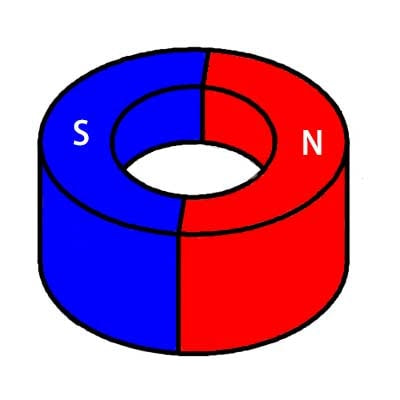
Features:
The alignment of magnetic domains is that the magnetic flux lines radiate outward (or inward) from a central axis, perpendicular to the material’s surface. This configuration is distinct from axial or parallel magnetization, where magnetic poles are aligned along a single axis.
Key Applications:
Brushless DC (BLDC) motors & generators, Magnetic couplings, Magnetic gears, Levitation systems, Acoustic devices, Scientific & medical equipment, etc
Advantages:
| Uniform Field Distribution | Radial magnetization ensures a highly uniform magnetic field in the radial direction, making it ideal for applications requiring consistent magnetic performance across a specific area. |
| Enhanced Magnetic Efficiency | The radial alignment optimizes the magnetic flux path, reducing leakage and improving the overall efficiency of magnetic circuits, which is crucial for energy-sensitive applications. |
| Compact Design | Radially magnetized components can be designed to fit into confined spaces, offering a space-saving solution for miniaturized devices without compromising magnetic performance. |
| Customizable Field Strength | By adjusting the material properties, dimensions, or magnetization process, the magnetic field strength can be precisely tailored to meet application-specific requirements. |
| Reduced Cogging Torque | In motor and generator applications, radial magnetization minimizes cogging torque, leading to smoother operation, reduced noise, and extended equipment lifespan. |
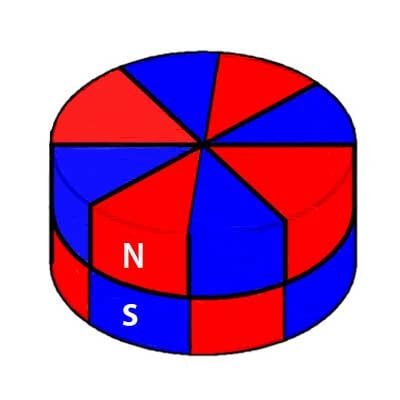
Features:
It devides a magnetic material into multiple alternating magnetic poles (north & south) along its circumference or surface, it creates a series of distinct magnetic regions, each with its own magnetic polarity(2-pole, 8-pole, etc). This arrangement can be achieved through advanced magnetization techniques.
Key application:
Automotive Industry, Robotics, Consumer electronics, Scientific research(particle accelerators), Medical devices, Loudspeakers and audio equipment, Magnetic Couplings(pumps, mixers), Magnetic sensors and encoders(automotive speed sensors, magnetic scales), Brushless DC (BLDC) motors, etc
Advantages:
| Enhanced Resolution and Precision | The presence of multiple poles allows for finer angular or spatial resolution, making multi-pole magnets ideal for applications requiring precise positioning, such as in encoders, resolvers, and stepper motors. |
| Improved Torque Characteristics | In motors and actuators, multi-pole magnetization increases the number of torque-producing cycles per revolution, leading to smoother operation, higher torque density, and reduced torque ripple. |
| Compact and Lightweight Design | By leveraging the magnetic field’s spatial distribution, multi-pole magnets can achieve high performance in smaller packages, enabling the development of lighter, more energy-efficient devices. |
| Customizable Pole Patterns | The ability to tailor the number, width, and strength of magnetic poles allows for optimization of magnetic performance to suit specific application requirements, offering greater design flexibility. |
| Reduced Cogging and Vibration | In rotating machinery, multi-pole configurations minimize cogging effects and mechanical vibrations, resulting in quieter operation and extended equipment lifespan. |
| Enhanced Magnetic Coupling | Multi-pole magnets can improve the efficiency of magnetic couplings and clutches by providing more effective magnetic flux paths and stronger attractive/repulsive forces. |
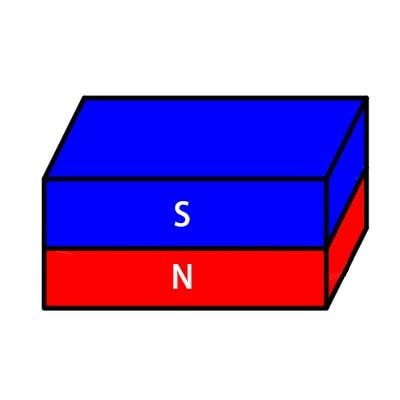
Features:
Refers to the process of magnetizing a material uniformly across its entire thickness, ensuring consistent magnetic properties from one surface to the opposite. It is achieved through specialized electromagnetic fields or advanced magnetization processes that penetrate deeply into the material, creating a uniform magnetic domain structure.
Key applications:
- Holding and mounting systems, Magnetic assemblies, Rectangular pot magnets, Magnetic poster hangers, Concrete insert magnets, Actuators and linear motion, Sensors, Magnetic separation, Consumer electronics, Electric motors and generators, Magnetic storage devices, Energy harvesting and conversion, etc
Advantage:
| Enhanced Performance | Uniform magnetization across the thickness leads to improved magnetic performance, including higher magnetic induction and reduced magnetic losses. This is particularly beneficial in applications requiring high magnetic efficiency, such as electric motors and transformers. |
| Improved Reliability | Consistent magnetic properties throughout the material thickness enhance the reliability and longevity of magnetic components, reducing the risk of premature failure due to localized magnetic variations. |
| Versatility | Suitable for a wide range of materials, including soft magnetic alloys, hard magnetic materials, and certain non-ferromagnetic materials when combined with specific coating or doping techniques. |
| Advanced Design Flexibility | Enables the creation of complex magnetic structures and patterns, facilitating innovative designs in magnetic devices and systems. |

Features:
Custom magnetization meets unique application requirements through specialized pole arrangements, which is the non-uniform magnetic fields across the surface or volume of a magnet. This allows for highly specific and localized magnetic effects tailored to unique applications.
Key applications:
High-resolution linear and rotary encoders, Shaped field actuators, Customized magnetic gears and couplings, High-security access cards and keys, Asset tracking, MRI enhancement, Fundamental studies of magnetic materials and interactions, Magnetic fixtures with tailored holding forces, etc
Advantages:
| Enhanced Performance | Custom patterns optimize magnetic flux distribution, improving efficiency, sensitivity, or force generation in devices. |
| Space and Weight Savings | Complex functionalities can be integrated into smaller components, reducing system size and weight. |
| Reduced Costs | Eliminates the need for multiple standard magnets or mechanical components by consolidating functions into a single magnetized part. |
| Design Flexibility | Enables innovation in product design by overcoming limitations of standard magnetization types. |
